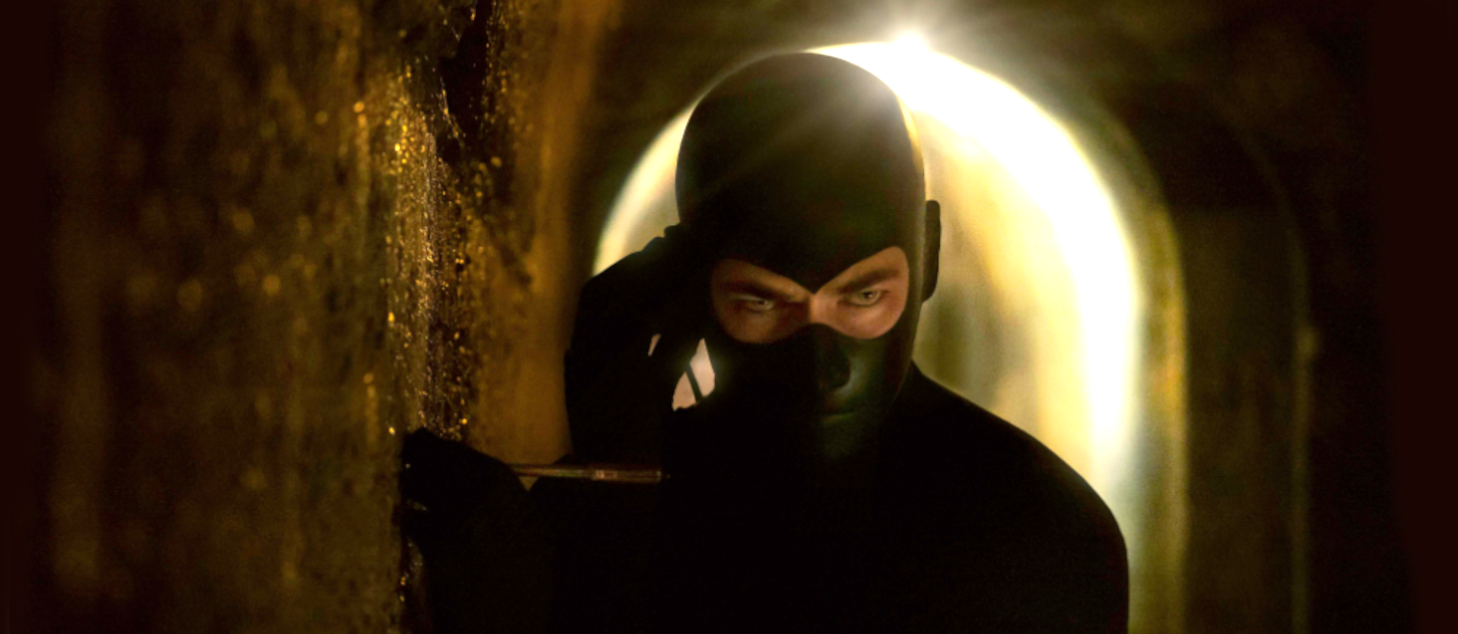The Diabolik Trilogy
Italy’s anarchic master thief gets a Covid-era trilogy of films that hew fairly closely to stories from the original Giussani comic books: Diabolik, Diabolik: Ginko Attacks!, Diabolik: Who Am I? It’s all very serious, literal and evenly paced, but can boast terrific art direction and a couple of intriguing characterizations. We’re impressed by the faithful adaptations — the producing-writing-directing Manetti brothers go out of their way not to look like modern attention-deficit overkill action fare. And they can’t be accused of copying Mario Bava.

The Diabolik Trilogy
Blu-ray
KL Studio Classics
2020, 2022, 2023 / Color / 2:35 widescreen / 139, 115, 129 min. / Street Date July 29, 2025 / available through Kino Lorber / 49.95
Starring: Luca Marinelli, Giancarlo Gianiontti, Miriam Leone, Valerio Mastandrea, Monica Bellucci, Pier Giorgio Bellocchio, Alessio Lapice.
Cinematography: Francesca Amitrano, Angelo Sorrentino
Production Designer: Noemi Marchica
Costume Designer: Ginevra De Carolis
Film Editor: Federico Maria Maneschi
Music Composers: Aldo De Scalzi, Pivio, Calibro 35, Enrico Gabrielli
Screenplays by Antonio & Marco Manetti with Michelangelo La Neve & Mario Gamboli based on characters created by Angela & Luciana Giussani
Produced by Carlo Macchitella, Paolo Del Brocco, Antonio Manetti, Marco Manetti, Pier Giorgio Bellocchio
Directed by Antonio & Marco Manetti
 This ambitious film trilogy from the Italian Manetti Brothers was a conspicuous casualty of the Covid-19 pandemic. The Italian premiere of the first feature was reportedly delayed, and the series saw no release in the U.S. at all. Most of the coverage online had an ‘in passing’ approach, rather than recognizing the films’ interesting qualities. The older Mario Bava adaptation continues to be discovered by new generations of film fans, so where is the curiosity for this trio of retro-styled thrillers? We were surprised to see the the three features given such low ratings online.
This ambitious film trilogy from the Italian Manetti Brothers was a conspicuous casualty of the Covid-19 pandemic. The Italian premiere of the first feature was reportedly delayed, and the series saw no release in the U.S. at all. Most of the coverage online had an ‘in passing’ approach, rather than recognizing the films’ interesting qualities. The older Mario Bava adaptation continues to be discovered by new generations of film fans, so where is the curiosity for this trio of retro-styled thrillers? We were surprised to see the the three features given such low ratings online.
The only fair way to assess The Diabolik Trilogy is to approach it as if the Mario Bava version didn’t exist. The adaptations’ avowed intention was to faithfully adapt the original Angela and Lucian Giussani comic books. The Manettis apply a deliberate pace, which is very out of keeping with current action film trends. The storylines are slow, sometimes to the point of distraction. The story turns are spelled out in such literal detail that we are indeed reminded of the original Feuillade serials. Franju’s Judex had a reason to look antiquated, as he wished to evoke a nostalgia for 1912, reproducing the innocence of that earlier age.
The Diabolik brand is treated as if it were sacred territory. The Manettis consistently avoid making their Diabolik play like a modern comic book picture. There is no endless martial arts combat, dizzying editing or CGI camera gymnastics. The characters go about their fantastic criminal business without humor or ironic overtones. Even the makers of the 1914 Fantomas communicated the fun of penny-dreadful ‘thriller’ conventions. These Diabolik pictures are for the most part played utterly straight, as if the audience held the originals as sacred texts not to be toyed with.
Kino lists the first film Diabolik as from 2020 but the IMDB gives its premiere release date as late in 2021. A full origin story is saved for film #3, while this first chapter instead depicts how Eva Kant (Miriam Leone) becomes the loving cohort and consort of Diabolik (Luca Marinelli). Together they pull off an incredible bank heist, which involves multiple murders. Inspector Ginko (Valerio Mastandrea) leads the ongoing effort to arrest Diabolik, but his reasonable efforts come to nothing. Diabolik is a master of disguises. Even when the entire police force corners him he manages to escape, often in a black Jaguar.

All three stories take place in original Giussani territory, a fictitious Italophone country called Clerville (or is that just the capital?) in the 1960s. Most things look Italian but police uniforms are a dead match for those worn by old-style New York City cops.
Diabolik: Ginko Attacks (Diabolik: Ginko all’attacco!) sees Diabolik and Eva working as a committed team. Ginko’s cops trace Diabolik’s home, his main headquarters and a workshop where he fabricates his disguises and gimmicks, but can’t quite catch him. Abandoned by Diabolik during an escape, Eva offers to help Ginko if she’ll be allowed to leave the country. The authorities force Ginko to take the deal, which is of course a plot by the daring thieves to recoup all of their stolen treasures.
In the two sequels Diabolik is played by Giacomo Gianniotti. Another added wrinkle is that Ginko acquires a love interest, the Duchess Altea di Vallemberg. She’s played by the established star Monica Bellucci, and the two make a mature, rather formal couple. As she’s foreign royalty they must keep their relationship a secret.
Diabolik: Who Are You? (Diabolik: Chi sei?) chooses a comic book story with an excellent opening gambit: Diabolik and Eva’s heist of a priceless coin collection is spoiled by a gang of reckless terror-thieves armed with machine guns. Both Diabolik and Ginko end up a prisoners of the gang; Eva and the Duchess Vallemberg must join forces to rescue them. When the notorious criminal and the head cop are chained together in a dungeon, the series momentarily evokes the vibe of an old Fantomas book.
We admire the consistency of the Manetti brothers’ approach, even if their thrillers trend away from what is expected in successful action films of the 2020s. The overall look and context is excellent. The films have brilliantly-styled streets, terrific interior designs and an impressive selection of secret lairs for our master thief. The music alternates between lush Italo-lounge vocals, and restrained action cues.
Instead of packing the movies with incident, each installment has only one or two major heist set-pieces … and their average running time is 127 minutes. More happens in 25 minutes of a Marvel or Mission: Impossible picture than in all three of these pictures combined. The second half of Diabolik is fairly peppy, but the first half persists in long, very literal sequences spelling out exactly what is happening. Several minutes can go by between anything promising action. We watch the elegant Eva Kant deal with a blackmailer, or Ginko smoke his pipe while sidestepping the micro-managing of the Minister of Justice.
These very intentional style decisions will not please everybody. There are a lot of full entrances and exits. When Ginko’s men respond to a report of a trap door in a woman’s yard, we see 20 seconds of cop cars approaching her house, instead of jumping right to their arrival. Logical plot details are explained and re-explained: hotel managers and bank employees inquire why a waiter is missing or why a particular safety deposit room is being used.
The visuals do employ attractive affectations, such as split screens for parallel action, and animated maps and diagrams to explain the security for a vault. Eva and Diabolik secretly communicate in Morse Code, which for us spells out in very nice stylized subtitles.
Relationship nuance is kept to bare minimum, leaving the actors to flesh out the roles. Miriam Leone’s Eva Kant is described as an heiress, reformed from an earlier criminal life. She chooses Diabolik because he’s the only man she’s met who doesn’t bore her to tears. Ms. Leone cultivates the cool elegance of Grace Kelly or Catherine Deneuve; we take note that, back in the 1960s, an abandoned attempt at a Diabolik feature filmed for a couple of weeks with Catherine Deneuve in the role.
Valerio Mastrandea’s Inspector Ginko is ideal. He exudes sane authority and is obviously the right man to chase down a master criminal. Bad luck keeps ruining his perfect traps and ambushes, along with the fumbles of flatfoot cops that can’t do anything right. Ginko does have a faithful second in Sergeant Palmer (Pier Giorgio Bellochio), who offers sound advice. Why Ginko keeps guarding key crucial sites with just one or two street cops, is a mystery. What Clerville really needs is a dedicated anti-Diabolik squad.

The weak link in all three movies is Diabolik himself. Luca Marinelli from the first show has almost zero charisma; he can arch his eyebrows into the accepted Diabolik glare, but there’s no criminal fever in his demeanor. He’s directed to maintain the same stare at all times. The resulting neutral performance sometimes resembles an early-era CGI creation. ←
His replacement Giacomo Gianiotti looks slightly better in the face, but the eyebrows, haircut and rubber mask are still doing most of the work. We’re surprised when we start to warm up to him in the second sequel. Both actors move well and could look like animated modern sculptures, but the direction doesn’t often invite us to simply observe them in motion. This Diabolik spends a lot of time in in the shadows, or operating in disguise.
That brings us to more negative complications. Diabolik brings stealth and gimmicks to the table, with only a medium level of criminal genius. His disguises are an unfair advantage. He can fabricate imperceptible rubber masks of anyone he wants to impersonate; by the second movie Eva is making herself look exactly like other people as well. (How they adjust for height and weight, isn’t explained.)
The masks are visualized with perfect CGI transformations. Faces ‘pull off’ a supporting actor, revealing Marinelli, Gianiotti or Leone underneath. The problem is that Ginko never adjusts for this new reality, that renders visual ID methods completely invalid. He warns his men that anybody can be Diabolik, but continues to accept people at ‘face value.’
Staying faithful to the original comic books has its problems. The French Barbarella comic introduced unexpected erotic situations, while the Giussanis pushed criminal ruthlessness far beyond the norm by glamorizing a murderous thief. Diabolik kills most often by throwing knives. His main targets are guards and cops, who he murders as a matter of course. Why Ginko’s cops are so jolly is unclear, because Diabolik wipes them out left and right. By the end of the second film, he’s a little less vicious, but not by much. He pays off one previous female companion, and refrains from killing a lady cop.
The first film has an ice-cold scene where someone who double-crossed Eva is re-routed to an appointment with a guillotine, an outrage so bald that the movie simply skips explaining what happens afterwards. It’s a really graphic scene. As the victim is a respected pillar of the community, one would think Ginko’s entire department would be disbanded. The franchise’s ‘open season’ on killing police has always been a sticking point, too. We were never comfortable with this aspect of the comic (or the Bava film, to be honest). Feuillade’s Fantomas and The Vampires sometimes engaged in a cultural nihilism, as if protesting the utter abandonment of human values in the slaughter of World War 1. We note that the Saban animated TV series (1997) Diabolik drops the character’s nihilistic anti-law bent. Its murderous thief fights criminals, more or less like Batman.
The third movie takes it for granted that we’ve accepted Diabolik and Eva as criminal royalty, and that we’re now ready to feel as warmly to them as we do Ginko and the Duchess, whose main romantic problem is an inability to kiss in public. An extended flashback origin story for Diabolik explains his name and his technological skills, although we’d really like to know how he can build exotic tunnels with trap doors wherever they’re convenient, and how he keeps all those lush cribs, hideouts, labs and car passageways in such immaculate condition. Some of his gadgets are practical but others verge on the lame side. An elevating-car gag that works more or less like Professor Fate’s Hannibal 8 in The Great Race.
Also in the third movie comes one moment that just contradicts the whole Diabolik ethos. He sneaks into a house at night, and ‘BOP!’ is knocked unconscious by an unseen assailant. It’s not exactly what we expect from our master crook.
Each film ends with Eva and Diabolik gloating over their success like a pair of selfish Yuppies. The final film concludes at a funeral for a fallen cop, but we remember the scores Diabolik has killed. We’re just getting to know Giacomo Gianniotti as Diabolik, just as the series ends.
The Diabolik Trilogy has its good qualities, especially the stylized ’60s décor. It is apparently faithful to the original comic books, and credits the specific stories that were adapted. Perhaps the Manettis were hoping the audience would embrace their choice of a deliberate pace, with everything spelled out and over-clarified. It’s certainly different, but it won’t win over contemporary audiences that demand sensory overkill, just to stay awake.
The KL Studio Classics Blu-ray of The Diabolik Trilogy is a slick package for these handsomely-produced features. The stylization isn’t as acute as in a Dario Argento movie but the camera moves are adroit and each composition carefully designed. An effects reel added as an extra on the first movie shows real locations altered to ‘simplify’ settings, removing extraneous detail. Downtown Clerville looks underpopulated but nicely maintained.
The soundtrack contains a signature Diabolik tune and some cool & jazzy themes that fit in with the period. The digital effects make the mask changes and Diabolik’s various trap door illusions look perfect. These are some of the most stylish supervillain lairs we’ve seen. We like that the film doesn’t try to impress us by building incredible sets that are barely seen.
Besides the quick digital effects piece, the second two discs contain trailers and making-of featurettes that remind us that the trilogy did make an impact in Europe.
We were all ready to try out a comparison with the beloved Mario Bava film, but the differences are so great that some superficial observations will do. The Manettis’ Diabolik wears a visually perfect rubber mask and a standard Feuillade black leotard. It’s of course more practical than John Philip Law’s tailored leather costume but nowhere near as visually impressive. The characterizations are much closer to the comic book, with all three main characters made to be stoic and unemotional. Bava’s adaptation of course channels the trendy ‘camp’ aspects of Batman and jokey spy gadgetry; the tone is Cool Comedy. John Philip Law and Marisa Mell generate plenty of erotic chemistry, as a Mod super-couple that just happen to be the most wanted criminals in the world.
We also realize just how much of the old Danger: Diabolik is Bava’s imagination at work. His wide-angle camerawork and dynamic direction capture a genuine comic-book vibe, where every angle could be a panel from a Marvel publication. It may take another viewing to fully appreciate what the Manettis have done with the Diabolik franchise.
Reviewed by Glenn Erickson

The Diabolik Trilogy
Blu-ray rates:
Movies: Good
Video: Excellent
Sound: Excellent
Supplements:
Featurette VFX Breakdown
The Making of Diabolik: Ginko Attacks!
The Making of Diabolik: Who Are You?
Trailers.
Deaf and Hearing-impaired Friendly? YES; Subtitles: English (feature only)
Packaging: One Blu-ray in Keep case
Reviewed: July 31, 2025
(7365diab)
Visit CineSavant’s Main Column Page
Glenn Erickson answers most reader mail: cinesavant@gmail.com
Text © Copyright 2025 Glenn Erickson










